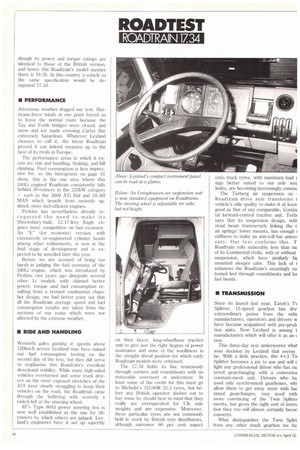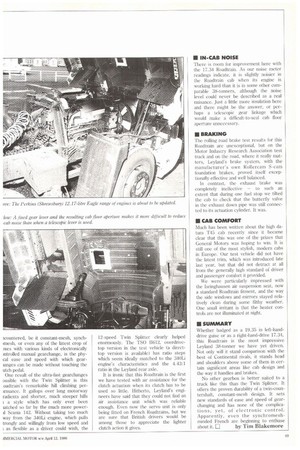ROADTEST
Page 56

Page 57

If you've noticed an error in this article please click here to report it so we can fix it.
ROADTRAIN 1734
though its power and torque ratings are identical to those of the British version, and hence this Roadtrain's model number there is 19.35. In this country a vehicle to the same specification would be designated 17.34.
• PERFORMANCE Attrocious weather dogged our test. Hurricane-force winds at one point forced us to leave the normal route because the Tay and Forth bridges were closed, and snow and ice made crossing Carter Bar extremely hazardous. Whatever Leyland chooses to call it, the latest Roadtrain proved it can indeed measure up to the best of its rivals in Europe.
The performance areas in which it excels are ride and handling, braking, and hill climbing. Fuel consumption is less impressive for, as the histograms on page 51 show, this is the one area where this 340Li engined Roadtrain consistently falls behind 38-tonners in the 223kW category — such as the 3600 ATi Daf and 19.361 MAN which benefit from recently updated, more fuel-efficient engines.
Perkins has nevertheless already recognised the need to make its Shrewsbury-built, 12.17-litre Eagle engines more competitive on fuel economy. An "E" (for economy) version, with extensively re-engineered cylinder heads among other refinements, is now in the final stage of development and is expected to be unveiled later this year.
Before we are accused of being too harsh in judging the fuel economy of the :340Li engine, which was introduced by Perkins two years ago alongside several other Li models with claimed better power, torque and fuel consumption resulting from a revised combustion chamber design, we had better point out that all the Roadtrain average speed and fuel consumption results are taken from the sections of our route which were not affected by the extreme weather.
RI RIDE AND HANDLING Westerly gales gusting at speeds above 120kmib across Scotland may have ruined our fuel consumption testing on the second day of the test, but they did serve to emphasise this Roadtrain's excellent directional stability. While many high-sided vehicles overturned and some truck drivers on the most exposed stretches of the A74 were clearly struggling to keep their vehicles on the road, the Roadtrain came through the buffeting with scarcely a twitch felt at the steering wheel.
'ars Type 8043 power steering box is now well established as the one for 38tonners by which others are judged. Leyland's engineers have it set up superbly on their latest, long-wheelbase tractive unit to give just the right degree of power assistance and none of the woolliness in the straight ahead position for which early Roadtrain models were criticised.
The 17.34 holds its line tenaciously through corners and roundabouts with no noticeable oversteer or understeer. At least some of the credit for this must go to Michelin's 315/80R 22.5 tyres, but before any British operator dashes out to buy some he should bear in mind that they really are overspecified for UK axle weights and are expensive. Moreover, these particular tyres are not commonly held in stock by British tyre distributors, although narrower 80 per cent aspect ratio truck tyres, with maximum load t ings better suited to our axle wet; limits, are becoming increasingly commo The Terberg air suspension on I Roadtrain drive axle transforms t vehicle's ride quality to make it at least good as that of any comparable, Contin• tal forward-control tractive unit. Terbt says that its suspension design, with stout beam transversely linking the t air springs' lower mounts, has enough i stiffness to make an anti-roll bar unneo sary. Our test confirms this. T Roadtrain rolls noticeably less than ma of its Continental rivals, with or without suspension, which have similarly till mounted sleeper cabs. This lack of enhances the Roadtrain's asstuingly sui footed feel through roundabouts and loi fast bends_ • TRANSMISSION
Since its launch last year, Eaton's Tv Splitter, 12-speed gearbox has dra, extraordinary praise from the vehii manufacturers, operators and drivers w have become acquainted with pre-prod& tion units. Now Leyland is among t manufacturers which will offer it as an c tion.
This three-day test underscores what wise decision by Leyland that seems be. With a little practice, the 4x3 TN,t Splitter becomes a joy to use and will d light any professional driver who has ma tered gearchanging with a conventiot constant-mesh unit. Drivers who ha used only synchromesh gearboxes, whi allow them to get away more with bac timed gearchanges, may need rath more convincing of the Twin Spline] merits, but given the right sort of instru don they too will almost certainly becon converts.
What distinguishes the Twin Splitt from any other truck gearbox we ha 'countered, be it constant-mesh, synchimesh, or even any of the latest crop of .ixes with various kinds of electronically introlled manual gearchange, is the phycal ease and speed with which gearranges can be made without touching the utch pedal.
One result of the ultra-fast gearchanges ossible with the Twin Splitter is this .oadtrain's remarkable hill climbing perirrnance. It gallops over long motorway radients and shorter, much steeper hills a style which has only ever been tatched so far by the much more power
ii 142. Without taking too much way from the 340Li engine, which pulls trongly and willingly from low speed and ; as flexible as a driver could wish, the
12-speed Twin Splitter clearly helped enormously. The TS0 11612, overdrivetop version in the test vehicle (a directtop version is available) has ratio steps which seem ideally matched to the 340Li engine's characteristics and the 4.43:1 ratio in the Leyland rear axle.
It is ironic that this Roadtrain is the first we have tested with air assistance for the clutch actuation when its clutch has to be used so little. Hitherto, Leyland's engineers have said that they could not find an air assistance unit which was reliable enough. Even now the servo unit is only being fitted on French Roadtrains, but we are sure that British drivers would be among those to appreciate the lighter clutch action it gives. • IN-CAB NOISE Therc is room tor improvement here with the 17.34 Roadtrain. As our noise meter readings indicate, it is slightly noisier in the Roadtrain cab when its engine is working hard than it is in some other comparable 38-tonners, although the noise level could never be described as a real nuisance. Just a little more insulation here and there might be the answer, or perhaps a telescopic gear linkage which would make a difficult-to-seal cab floor aperture unnecessary.
1111 BRAKING The rolling road brake test results for this Roadtrain are unexceptional, but on the Motor Industry Research Association test track and on the road, where it really matters, Leyland's brake system, with the manufacturer's own Rollercam S-cam foundation brakes, proved itself exceptionally effective and well balanced.
In contrast, the exhaust brake was completely ineffective — to such an extent that during one fuel stop we tilted the cab to check that the butterfly valve in the exhaust down pipe was still connected to its actuation cylinder. It was.
• CAB COMFORT Much has been written about the high datum T45 cab recently since it became clear that this was one of the prizes that General Motors was hoping to win. It is still one of the most stylish, modern cabs in Europe. Our test vehicle did not have the latest trim, which was introduced late last year. but that did not detract at all from the generally high standard of driver and passenger comfort it provided.
We were particularly impressed with the Isringhausen air suspension seat, now a standard Roadtrain fitment, and the way the side windows and mirrors stayed relatively clean during some filthy weather. One small irritant is that the heater controls are not illuminated at night.
• SUMMARY Whether badged as a 19.35 in left-handdrive guise or as a right-hand-drive 17.34, this Roadtrain is the most impressive Leyland 38-tonner we have yet driven. Not only will it stand comparison with the best of Continental rivals, it stands head and shoulders above some of them in certain significant areas like cab design and the way it handles and brakes.
No other gearbox is better suited to a truck like this than the Twin Splitter. It offers the proven durability of a twin-countershaft, constant-mesh design. It sets new standards of ease and speed of gearchanging and has none of the complications, yet, of electronic control. Apparently, even the synchromeshminded French are beginning to enthuse
about it. 11 by Tim Blakemore






























































